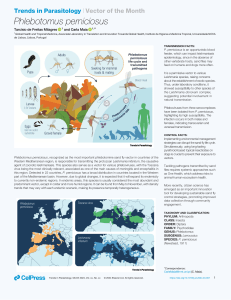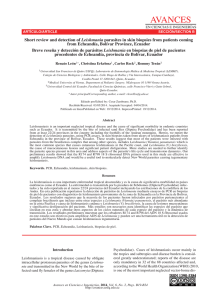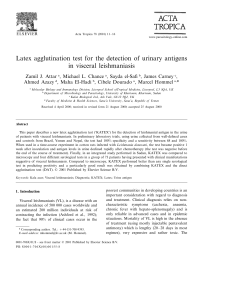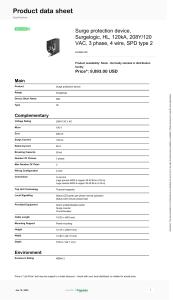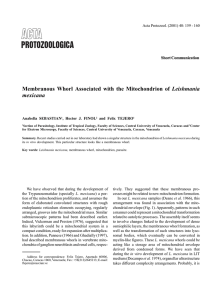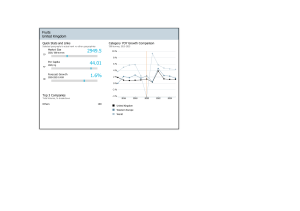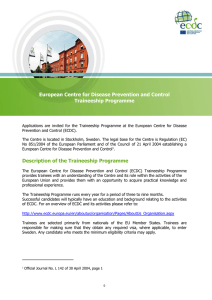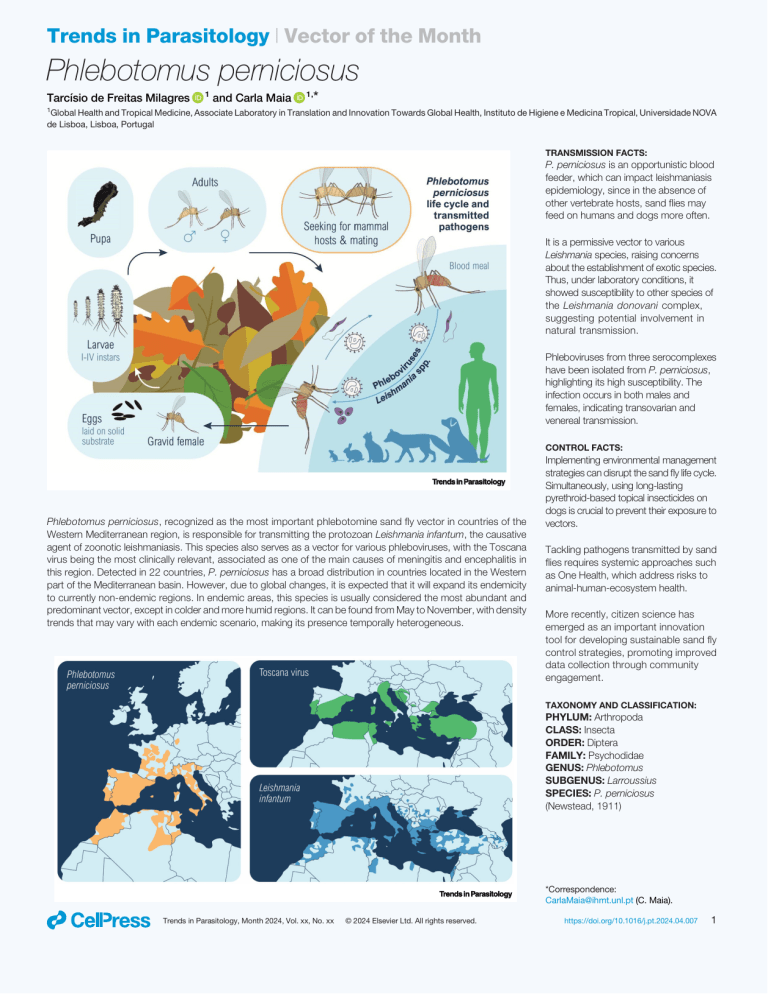
Trends in Parasitology | Vector of the Month Phlebotomus perniciosus Tarcísio de Freitas Milagres 1 and Carla Maia * 1, 1 Global Health and Tropical Medicine, Associate Laboratory in Translation and Innovation Towards Global Health, Instituto de Higiene e Medicina Tropical, Universidade NOVA de Lisboa, Lisboa, Portugal TRANSMISSION FACTS: P. perniciosus is an opportunistic blood feeder, which can impact leishmaniasis epidemiology, since in the absence of other vertebrate hosts, sand flies may feed on humans and dogs more often. It is a permissive vector to various Leishmania species, raising concerns about the establishment of exotic species. Thus, under laboratory conditions, it showed susceptibility to other species of the Leishmania donovani complex, suggesting potential involvement in natural transmission. Phleboviruses from three serocomplexes have been isolated from P. perniciosus, highlighting its high susceptibility. The infection occurs in both males and females, indicating transovarian and venereal transmission. CONTROL FACTS: Trends in Parasitology Phlebotomus perniciosus, recognized as the most important phlebotomine sand fly vector in countries of the Western Mediterranean region, is responsible for transmitting the protozoan Leishmania infantum, the causative agent of zoonotic leishmaniasis. This species also serves as a vector for various phleboviruses, with the Toscana virus being the most clinically relevant, associated as one of the main causes of meningitis and encephalitis in this region. Detected in 22 countries, P. perniciosus has a broad distribution in countries located in the Western part of the Mediterranean basin. However, due to global changes, it is expected that it will expand its endemicity to currently non-endemic regions. In endemic areas, this species is usually considered the most abundant and predominant vector, except in colder and more humid regions. It can be found from May to November, with density trends that may vary with each endemic scenario, making its presence temporally heterogeneous. Implementing environmental management strategies can disrupt the sand fly life cycle. Simultaneously, using long-lasting pyrethroid-based topical insecticides on dogs is crucial to prevent their exposure to vectors. Tackling pathogens transmitted by sand flies requires systemic approaches such as One Health, which address risks to animal-human-ecosystem health. More recently, citizen science has emerged as an important innovation tool for developing sustainable sand fly control strategies, promoting improved data collection through community engagement. TAXONOMY AND CLASSIFICATION: PHYLUM: Arthropoda CLASS: Insecta ORDER: Diptera FAMILY: Psychodidae GENUS: Phlebotomus SUBGENUS: Larroussius SPECIES: P. perniciosus (Newstead, 1911) Trends in Parasitology Trends in Parasitology, Month 2024, Vol. xx, No. xx © 2024 Elsevier Ltd. All rights reserved. *Correspondence: CarlaMaia@ihmt.unl.pt (C. Maia). https://doi.org/10.1016/j.pt.2024.04.007 1 Trends in Parasitology | Vector of the Month Acknowledgments The work was in part supported by Fundação para a Ciência e a Tecnologia, I.P. (funds to GHTM-UID/Multi/04413/2020 and LA-REAL-LA/P/0117/2020) and by the European Commission grant 101057690 and UKRI grants 10038150 and 10039289 and is catalogued by the CLIMOS Scientific Committee as CLIMOS number 004 (www.climos-project.eu). The contents of this publication are the sole responsibility of the author and do not necessarily reflect the views of the European Commission, the Health and Digital Executive Agency, or UKRI. Neither the EU nor granting authority nor UKRI can be held responsible. The funders had no role in study design, data collection and analysis, decision to publish, or preparation of the manuscript. For the purposes of Open Access, the author has applied a CC BY-ND public copyright licence to any Author Accepted Manuscript version arising from this submission. The six Horizon Europe projects, BlueAdapt, CATALYSE, CLIMOS, HIGH Horizons, IDAlert, and TRIGGER, form the Climate Change and Health Cluster. The figures were created using some functionalities of BioRender. Declaration of interests The authors declare no competing interests. Resources www.ecdc.europa.eu/en/disease-vectors/facts/phlebotomine-sand-flies www.ecdc.europa.eu/sites/default/files/documents/sand-flies-factsheet-references.pdf www.ecdc.europa.eu/en/publications-data/surveillance-prevention-control-leishmaniases-European-Union-and-neighbouring-countries www.ecdc.europa.eu/en/publications-data/spatial-relationship-between-presence-and-absence-leishmania-spp www.ecdc.europa.eu/en/toscana-virus-infection https://flebocollect.com/ Literature 1. Alten, B. et al. (2016) Seasonal dynamics of phlebotomine sand fly species proven vectors of Mediterranean leishmaniasis caused by Leishmania infantum. PLoS Negl. Trop. Dis. 10, e0004458 2. Ayhan, N. and Charrel, R. (2018) Sandfly-borne viruses of demonstrated/relevant medical importance. In Vectors and Vector-Borne Zoonotic Diseases (Savić, S., ed.), pp. 1–22, IntechOpen 3. Bettini, S. et al. (1986) Leishmaniasis in Sardinia: II. Natural infection of Phlebotomus perniciosus Newstead, 1911, by Leishmania infantum Nicolle, 1908, in the province of Cagliari. Trans. R. Soc. Trop. Med. Hyg. 80, 458–459 4. Campino, L. and Maia, C. (2018) The role of reservoirs: canine leishmaniasis. In Drug Resistance in Leishmania Parasites – Consequences, Molecular Mechanism and Possible Treatments (Ponte-Sucre, A. et al., eds), pp. 59–83, Springer International Publishing 5. de Freitas Milagres, T. et al. (2023) Same parasite, different outcomes: unraveling the epidemiology of Leishmania infantum infection in Brazil and Spain. Trends Parasitol. 39, 774–785 6. Dvorak, V. et al. (2018) Parasite biology: the vectors. In The Leishmaniases: Old Neglected Tropical Diseases (Bruschi, F. and Gradoni, L., eds), pp. 31–77, Springer International Publishing 7. Maia, C. (2024) Sand fly-borne diseases in Europe: epidemiological overview and potential triggers for their emergence and re-emergence. J. Comp. Pathol. 209, 6–12 8. Maia, C. et al. (2023) The estimated distribution of autochthonous leishmaniasis by Leishmania infantum in Europe in 2005–2020. PLoS Negl. Trop. Dis. 17, e0011497 9. Ortuño, M. et al. (2022) Exposure to Phlebotomus perniciosus sandfly vectors is positively associated with Toscana virus and Leishmania infantum infection in human blood donors in Murcia Region, southeast Spain. Transbound. Emerg. Dis. 69, e1854–e1864 10. Seblova, V. et al. (2015) Natural hybrid of Leishmania infantum/L. donovani: development in Phlebotomus tobbi, P. perniciosus and Lutzomyia longipalpis and comparison with non-hybrid strains differing in tissue tropism. Parasit. Vectors 8, 605 2 Trends in Parasitology, Month 2024, Vol. xx, No. xx © 2024 Elsevier Ltd. All rights reserved. https://doi.org/10.1016/j.pt.2024.04.007
